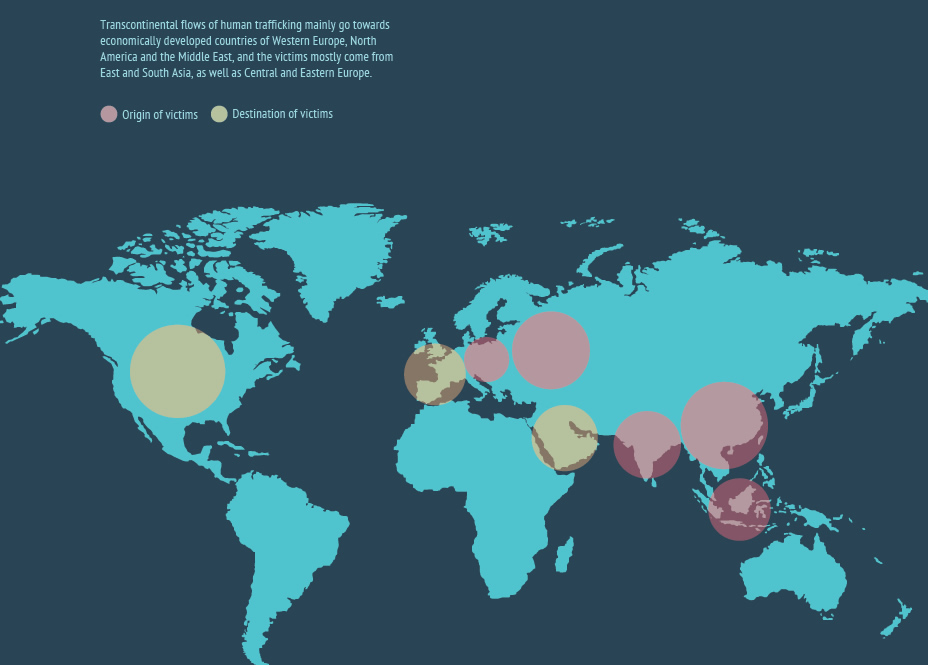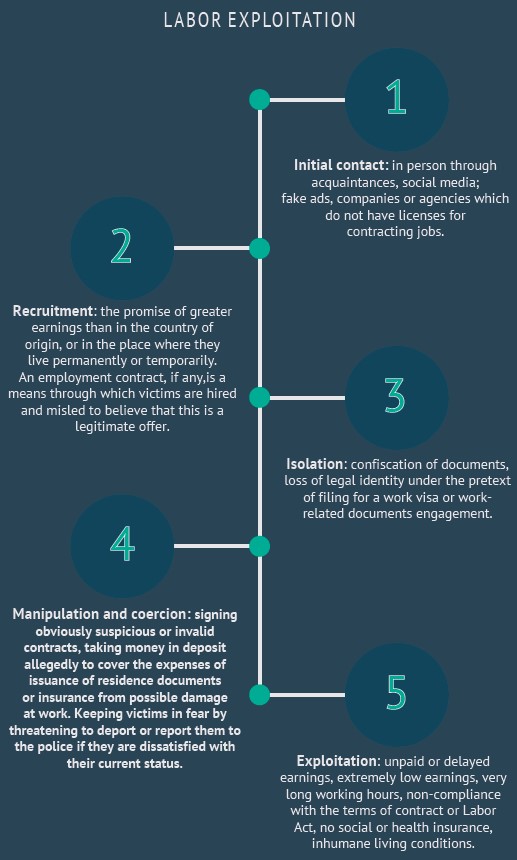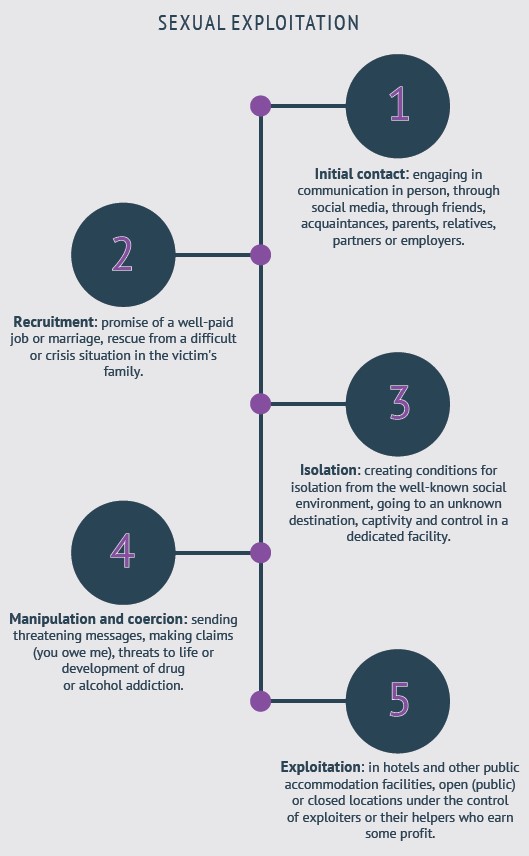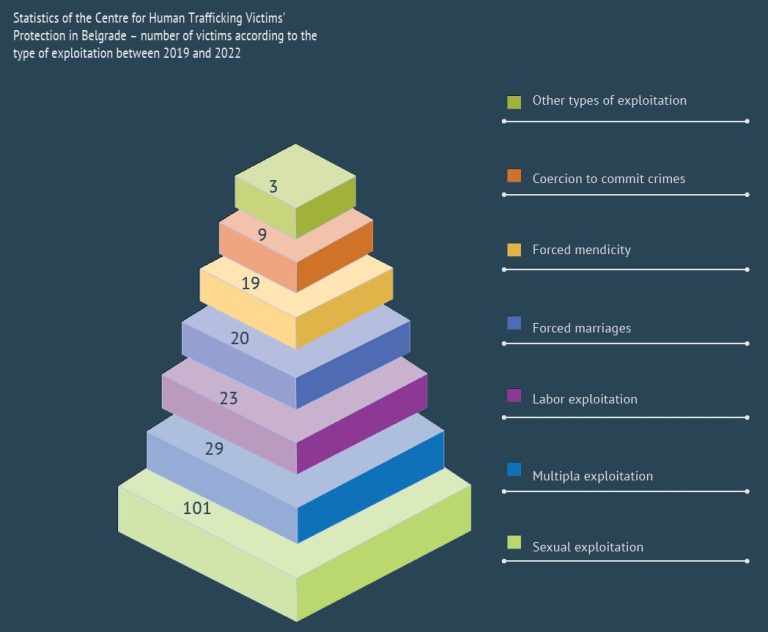Human trafficking
Serbia is the country of origin, transit and destination for human trafficking victims.
The most prevalent form of trafficking is internal human trafficking, where Serbian citizens are subjected to different types of exploitation. The dominant form of human trafficking is sexual exploitation.
Global and Regional Nature of the Issue
Human trafficking is a global problem that affects all countries regardless of the level of their social, political, economic and cultural development. It is recognized as one of the most widespread criminal activities and represents a form of modern slavery. At the global level, for the first time in twenty years, there has been a decrease in the number of identified victims of human trafficking. This decrease has most likely been caused by COVID-19 pandemic, because law enforcement authorities had a limited possibility to target the crime of human trafficking.
Human trafficking is increasingly moving online (recruitment, contacts, advertising on social media), giving perpetrators flexibility to transfer victims from one location to another, as well as to coordinate activities “from a distance”, reducing the detection risk and increasing profits. The most prevalent form of exploitation is still sexual exploitation. The EU has not registered a significant increase in human trafficking for the purpose of sexual exploitation, but it is happening in almost all member states. In recent years, there have been more and more reports of labor exploitation cases in the EU, and this type of exploitation will remain in place as long as there is a need for underpaid labor. Criminal groups which deal with this type of exploitation and are made up of members who are not EU citizens are occasionally linked to human trafficking, or are simultaneously involved in both criminal activities.
Victims are increasingly recruited online, and are promised well-paid jobs abroad with good working conditions that would solve their existential problems and give them stability.
According to data from the United Nations Office on Drugs and Crime (UNODC), in comparison with the period before 2019, more cases of internal human trafficking and multiple exploitation were detected in Western and Southwestern Europe.
Situation in Serbia
Serbia is still largely the country of origin, transit and final destination of victims of human trafficking. Internal trafficking where victims are domestic citizens is dominant. They are subjected to different forms of exploitation, but sexual exploitation prevails and it mostly affects underage persons of female sex. Other types of exploitation are also present – forced marriages, forced labor, mendicity and coercion to commit crimes.
Serbian citizens are most frequently – in more than 80% of cases – exploited in Serbia, and in less than 20% abroad, through forced marriages, forced mendicity, labor and multiple exploitation. The countries of destination are Western European countries with high living standards – Italy, France, Germany, Austria and Switzerland, and especially countries where prostitution is de facto legalized, such as the Netherlands and Malta. In addition to this, during the tourist season, sexual exploitation is also present in Montenegro and Croatia.
The average age of women who are victims of human trafficking is 23, while that of men is 27. Exploitation most frequently lasts between three months and three years. Most victims are from Belgrade, Novi Sad, Šabac, Jagodina, Pančevo, Subotica and Niš.


Labor exploitation is present both in Serbia and abroad, where Serbian citizens are exploited most frequently as low-skilled workers. Between 2015 and 2018, they were exploited as seasonal workers, workers in public transport, construction workers, workers in agriculture and in factories, hospitality services and as help at home. These activities were very popular, and in this period Serbia had a large number of agencies for mediation and work placement abroad. They worked without permits or completely illegally, taking advantage of the high demand for low-skilled workers in some EU member states. This trend partly continued after 2019, when new forms of labor exploitation were identified in the economy and agriculture. Victims were both Serbian citizens and foreigners, most frequently from Asian countries.
Mendicity as a form of exploitation in Serbia occurs in three forms: family mendicity, organized mendicity and spontaneous child mendicity. Forced mendicity as an element of the criminal offense of human trafficking can also be identified in the first two types. Family mendicity is the most frequent type of mendicity. Its detection is difficult, because in those cases parents force or directly encourage children to beg for money in the streets, in order to get sustenance. Organized mendicity is initiated by individuals who recruit children or adults (most frequently persons with disabilities) to beg for money that will benefit of that person. Criminal proceedings for family and organized mendicity have been successfully held in practice. Forced mendicity is the third most frequent type of exploitation.
A large number of recorded cases involve spontaneous child mendicity, or so-called living on the streets, in which mendicity is the main way for them to survive. The exact number of children who are involved in any of the three aforementioned types of mendicity is impossible to determine, given the specificity of this phenomenon and the fact that there is no uniform methodology for its recording. This phenomenon has to be monitored for the purpose of prevention, because these children are particularly exposed to the risk of different types of violence, deviant behavior and human trafficking.
The most common type of human trafficking is sexual exploitation, which most frequently occurs in Belgrade, Niš, Novi Sad, Subotica and Kikinda.
For the purpose of sexual exploitation, online platforms are used for the advertising of services.
The ‘loverboy’ technique is still used for recruitment, mostly of underage victims.
Among the recorded cases, an increase in the number of sexually exploited children has been observed.
Forced marriages are a type of human trafficking which in Serbia exist in two forms – when a girl voluntarily marries usually a foreign partner, unaware of his hidden intentions, and when children younger than 16 get married.
Marriages are most frequently arranged by family members, relatives and new acquaintances in exchange for a fee.
In order to get the victim’s consent, different methods of fraud or coercion are used, including blackmail, deception, gifts or promises of money and gifts.
In practice, marriages are usually not formal, but extramarital partnerships are concluded, characterized by numerous forms of abuse.
Such marriages are prevalent among the Roma national minority.
Coercion of minors and adults to commit crimes mainly refers to the coercion to theft and aggravated larceny.
In most cases, money is stolen from apartments in Serbia and abroad (Italy, Belgium, France), while assets that can be exchanged for cash on the black market (gold, copper, cell phones, etc.) are stolen from commercial institutions.

Multiple exploitation in most cases includes sexual exploitation and some other type of – most frequently labor – exploitation, but also forced mendicity and coercion to commit crimes.
In the period between 2019 and 2022, 204 victims of human trafficking were identified, including 188 Serbian citizens (92%). Most of them were women (155, or 76%), while men were present in 24% of cases (49). Out of the total number of identified victims, 45% (91) were minors, and 55% were adults (113). Underage persons accounted for 35% of all female victims.
In the period between 2019 and 2022, 85 criminal reports were filed for the crime of human trafficking, against 167 perpetrators. The perpetrators were mostly men (115, or 69%) of all age groups, but there were also women (52, or 31%) of the average age between 30 and 50 years.
In October 2021 in Belgrade, police arrested a criminal group which had been exploiting a 42-year-old disabled man (he had no legs) throughout Serbia since December 2014, taking advantage of his difficult situation. Regardless of the weather, the victim was forced to beg for money at busy intersections in Belgrade six days a week, and to give at least EUR 100 to the perpetrators every day.
In October 2020, a five-member criminal group was arrested in Serbia for human trafficking in Belgium. The members exploited three adult Serbian citizens, lying them that they would paint houses in Belgium for large amounts of money but then forcing them to steal. The victims were forced to steal several tons of copper and other types of metal every day from factories in the Belgian city of Charleroi, and then to sell them at scrap yards.

Expected Future developments
► The detection and reporting of the crime of human trafficking and the identification of its victims will be impeded by the development of modern communication techniques, i.e., by the fact that sexual exploitation is advertised on social media and that the place, time and price of sexual intercourse are arranged in the same way, without personal contact or by phone. Innovations that make advertising on limited-access portals possible contribute to the increase in sexual exploitation. The promotion of activities that conceal prostitution and/or labor and sexual exploitation is more and more frequently an integral part of social and other media.
► Due to their financial strengthening, inadequate sentencing policy and multiple times higher earnings of human traffickers, Middle Eastern countries represent a very suitable area for further development of sexual exploitation of women and girls from Serbia.
► Taking into account the facilitated entry into Serbia of South American citizens (Brazil, Cuba, Venezuela, Bolivia), as well as those from parts of the Asian continent (China, Vietnam, Thailand, Bangladesh), there are reasons to expect that they will be recruited for sexual exploitation (within so-called high-level prostitution) by criminal group members, both in Serbia and abroad.
► In view of the changes on the Serbian labor market as a result of the outflow of workforce abroad, as well as the lack of certain craft workers, two parallel processes can be expected – improvement of conditions for workers whose professions are in high demand and low offer, and the importation of workforce from other, especially Asian, countries (India, Bangladesh, Uzbekistan, Vietnam, etc.).
► Since the practice of separation of labor exploitation from undeclared work is still unclear, labor exploitation will be a challenge for criminal investigations and identification of human trafficking victims.
► Although for the time being there are no signs of human trafficking among migrants in Serbia, in view of the length of their stay at or outside reception centers, as well as insufficient funds for sustenance or payment for the remainder of their illegal travels to the desired destination, there is a big risk that they might be recruited and exploited in the countries where they are waiting and in the countries of final destination.
► The greater the increase of the number of foreign citizens who are coming to Serbia for tourism, business or to escape war-torn areas, the greater the human trafficking through all types of exploitation.


